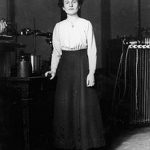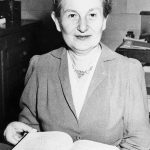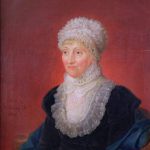- Hedwig in her laboratory, 1912. Source: Wikipedia
- Physicist Hedwig Kohn in her office at Wellesly College, circa 1950, at about the time she received a research award. Source: Jewish Women’s Archive
- Google’s Doodle for her Birthday Source: Google
Hedwig Kohn
Born: April 5, 1887 Died: November 26, 1964
What they did: Physicist
Facts:
- Hedwig was born in Breslau, Germany (modern day Wroclaw, Poland) to Jewish parents Georg and Helene.
- When she was 20, Hedwig entered Breslau University as an auditor, a year before women were actually allowed to attend, and earned her doctorate in physics in 1913, becoming the second woman to do so.
- In 1914, she as appointed as an assistant by her advisor, Otto Lummer, a physicist known for precision radiation measurements that contributed to Planck’s law.
- Her career would focus on radiation and spectroscopy.
- Throughout World War I, Hedwig taught and advised doctoral students, despite only being in her 20s.
- Her efforts were recognized and she received a medal after the war.
- In 1930, Hedwig earned Habilitation. This means she was now qualified to conduct teaching on her own and is a key step towards full professorship. During this time, she guided the work of eight doctoral students.
- In 1933, Hedwig was forced out of her position at the University for being Jewish.
- Due to a new Nazi law, “The Law for the Restoration of the Professional Civil Service” which prevented Jews from government service.
- Hedwig continued working in a small back room in the Physics Institute, fulfilling contracts for applied research.
- In 1935, Hedwig was able to work for 3 months in the Licht-Klimatisches Observatorium in Arosa, Switzerland where she measured ultra-violet light intensity from the sun. Unfortunately, this didn’t result in a permanent position.
- By 1938, Hedwig was without work or financial resources.
- With the growing violence and political hostility towards Jews, Hedwig realized that she needed to escape quickly. However, without a job or money, she was trapped.
- There were a lot of barriers to finding a job and escaping Nazi Germany for Hedwig.
- Lack of University jobs due to the Great Depression
- She was a well-respected physicist in Germany and was not she internationally known or a professor
- The fact she was foreign
- The fact she was German
- She was Jewish
- She was a woman
- Something else that made it impossible to obtain a U.S. visa was that the United States required applicants to have held a teaching job within the last two years and have held that position for two years.
- Finally, in 1938, physicist Rudolf Walter Ladenburg began working to help Hedwig immigrate to the U.S. Rudolf had been a lecturer at Breslau University and helped direct Hedwig’s doctoral research.
- Rudolf worked with the International Federation of University Women and the Society for the Protection of Science and Learning to secure Hedwig a job at Aberdeen University in Scotland in 1939.
- Unfortunately, before she could flee, war broke out and England immediately canceled all visas for “enemy aliens.”
- After this, there was an exchange of 70 letters between Hedwig, Rudolf, other prominent physicists, representatives of the American Association of University Women, and more as they tried to secure Hedwig another way out of Nazi Germany.
- Together, they were finally able to secure Hedwig 3 consecutive one-year positions at the Women’s College of the University of North Carolina, Sweetbriar College in Virginia, and Wellesley College in Massachussetts.
- This allowed her to secure a U.S. visa by way of a visa to Sweden in July of 1940.
- Though out of Nazi Germany, Hedwig’s troubles were not over. She still had to get from Stockholm Sweden to Greensboro, North Carolina. The only thing separating her from the U.S. was a war torn Atlantic Ocean.
- After a two month journey, Hedwig was finally able to make it to the United States in January of 1941.
- She started teaching at the Women’s College of the University of North Carolina at Greensboro, and stayed there for a year and a half.
- She was described as having a persistent optimism and good humor.
- She moved to the next University, Wellesley College in Massachusetts.
- There, she established a research laboratory for flame spectroscopy.
- She was well regarded at Wellesley and even won a college research
award. - She ended up staying at Wellesley until her retirement in 1952.
- After her retirement, she was awarded a pension and the title of professor emerita by the government of the Federal Republic of Germany.
- This is a title given to female professors who retire with honorable standing and they get to maintain the title of professor even after retirement.
- After she retired, for the next 12 years, she pursued independent research as a Research Associate at Duke University.
- While at Duke, Hedwig established a research laboratory, guided two graduate students to their doctorates, and recruited two post-doctoral fellows to assist with her study of flame spectroscopy.
- This work led to a breakthrough in the framework of combustion science and plasma physics.
- She continued this work until shortly before her death in 1964, when she was 77 years old.
Legacy
- Early in her career, Hedwig wrote 270 pages of a leading textbook called “Mueller-Pouillets Lehrbuch
der Physik” (Mueller-Pouillets Physics Textbook) and received one patent. - Her doctoral thesis was still being cited through the 1970s.
- She was most recently commemorated with the Google Doodle on April 5 th , 2019, which would have been her 132nd birthday.
- Google’s Doodle of Caroline Source: Google
- A telescope that William Herschel made for Caroline 1795
- Caroline Herschel at 78
- William and Caroline Herschel polishing a telescope lens, 1896 Lithograph.
Caroline Herschel
Born: March 16, 1750 Died: 1848
What they did: Cinderella of Science
Facts:
- Born Caroline Lucretia Herschel in Germany on March 16, 1750.
- She was the eighth child and fourth daughter of Isaac Herschel, a self-taught oboist, and his wife, Anna Ilse Moritzen.
- Her father who encouraged her education but a mother who wanted to keep her as a lifelong servant.
- When she was three years old, smallpox left her face scarred. Then, at age 10, typhus stunted her growth at 130 centimeters (4’3″) tall.
- Her family assumed that she would never marry and her mother felt it was best for her to train to be a house servant rather than becoming educated in accordance with her father’s wishes.
- Her father sometimes took advantage of her mother’s absence by tutoring her individually, or including her in her brother’s lessons, such as violin.
- Caroline was briefly allowed to learn dress-making.
- To prevent her from becoming a governess and earning her independence that way, she was forbidden from learning French or more advanced needlework than what she could pick up from neighbors.
- When she was 22, following her Father’s death her brothers William and Alexander rescued her, inviting her to live with them in Bath, England.
- Caroline did not blend in with the local society and made few friends, but was finally able to indulge her desire to learn, and took regular singing, English, and arithmetic lessons from her brother, and dance lessons from a local teacher.
- Eventually she became an integral part in William’s musical performances at small gatherings. She became the principal singer at his oratorio concerts, and acquired a reputation as a vocalist.
- She was offered an engagement for the Birmingham festival after a performance of Handel’s Messiah in April 1778, where she was the first soloist.
- She declined to sing for any conductor but William, and after that performance, her career as a singer began to decline.
- Caroline was subsequently replaced as a performer by distinguished soloists from outside the area because William wished to spend less time in rehearsals to focus on astronomy.
- When William became increasingly interested in astronomy, transforming himself from a musician to an astronomer, Caroline again supported his efforts.
- She said somewhat bitterly, in her Memoir, “I did nothing for my brother but what a well-trained puppy dog would have done, that is to say, I did what he commanded me.”
- In the 1770s, William started to build his own telescopes from lenses he had ground, unhappy with the quality of lenses he was able to purchase.
- Caroline would feed him and read to him as he worked, despite her desire to burnish her career as a professional singer.
- Caroline spent many hours polishing mirrors and mounting telescopes in order to maximize the amount of light captured.
- She learned to copy astronomical catalogs and other publications that William had borrowed.
- She also learned to record, reduce, and organize her brother’s astronomical observations. She recognized that this work demanded speed, precision and accuracy.
- She became a significant astronomer in her own right as a result of her collaboration with him.
- Caroline and William gave their last musical performance in 1782, when her brother accepted the private office of court astronomer to King George III.
- Caroline was asked to move from the high culture of Bath to the relative backwater of Datchet in 1782, a small town near Windsor Castle where William would be on hand to entertain royal guests.
- He presumed that Caroline would become his assistant, a role she did not initially accept.
- While William worked on a catalogue of 3,000 stars, studied double stars, and attempted to discover the cause of Mira’s and Algol’s variability, Caroline was asked to “sweep” the sky, meticulously moving through the sky in strips to search for interesting objects.
- On 28 August 1782 Caroline initiated her first record book. She inscribed the first three opening pages: “This is what I call the Bills & Rec.ds of my Comets”, “Comets and Letters”, and “Books of Observations”. This, along with two subsequent books, currently belong to the Herschel trove at the Royal Astronomical Society in London.
- On 26 February 1783, Caroline made her first discovery: she had found a nebula that was not included in the Messier catalog.
- That same night, she independently discovered Messier 110 (NGC 205), the second companion of the Andromeda Galaxy.
- Caroline was relegated to a ladder on William’s 20-foot reflector, attempting impossible measurements of double stars.
- William quickly realized his method of searching for nebulae was inefficient and he required an assistant to keep records.
- Naturally, he turned to Caroline.
- In the summer of 1783, William finished building a comet-searching telescope for Caroline, which she began to use immediately.
- Beginning in October 1783, the Herschels used a 20-foot reflecting telescope to search for nebulae.
- Initially, William attempted to both observe and record objects, but this too was inefficient and again turned to Caroline.
- She sat by a window inside, William shouted his observations, and Caroline recorded.
- This was not a simple clerical task, however, because she would have to use John Flamsteed’s catalogue to identify the star William used as a reference point for the nebulae. Because Flamsteed’s catalogue was organized by constellation, it was less useful to the Herschels, so Caroline created her own catalogue organized by north polar distance.
- The following morning, Caroline would go over her notes and write up formal observations, which she called “minding the heavens.”
- She discovered her first comet on 1 August 1786.
- Five of her comets were published in Philosophical Transactions. A packet of paper bearing the superscription, “This is what I call the Bills and Receipts of my Comets” contains some data connected with the discovery of each of these objects.
- William was summoned to Windsor Castle to demonstrate Caroline’s comet to the royal family. William recorded this phenomenon, himself, terming it “My Sister’s Comet.”
- Caroline Herschel is often credited as the first woman to discover a comet; however, Maria Kirch discovered a comet in the early 1700s, but is often overlooked because at the time, the discovery was attributed to her husband, Gottfried Kirch.
- In 1787, she was granted an annual salary of £50 (equivalent to £6,200 in 2019) by George III for her work as William’s assistant.
- Caroline’s appointment made her the first woman in England honored with an official government position, and the first woman to be paid for her work in astronomy—at a time when even men rarely received wages for scientific enterprises.
- It was the first money that Caroline had ever earned in her own right.
- She wrote a letter to the Astronomer Royal to announce the discovery of her second comet. The third comet was discovered on 7 January 1790, and the fourth one on 17 April 1790. All of these were discovered with her 1783 telescope.
- In 1791, Caroline began to use a 9-inch telescope for her comet-searching, and discovered three more comets with this instrument.
- Her last comet was discovered on 6 August 1797, the only comet she discovered without optical aid.
- In 1797 William’s observations had shown that there were a great many discrepancies in the star catalog published by John Flamsteed, which was difficult to use because it had been published as two volumes, the catalog proper and a volume of original observations, and contained many errors.
- William realized that he needed a proper cross-index to properly explore these differences but was reluctant to devote time to it at the expense of his more interesting astronomical activities.
- He therefore recommended to Caroline that she undertake the task, which ultimately took 20 months.
- The resulting Catalogue of Nebulae and Clusters of Stars was published by the Royal Society in 1798 and contained an index of every observation of every star made by Flamsteed, a list of errata, and a list of more than 560 stars that had not been included.
- In 1802, the Royal Society published Caroline’s catalogue in its Philosophical Transactions of the Royal Society A under William’s name. This listed around 500 new nebulae and clusters to the already known 2000.
- After her brother died in 1822, Caroline was grief-stricken and moved back to Hanover, Germany, continuing her astronomical studies to verify and confirm William’s findings.
- However, her observations were hampered by the architecture in Hanover, and she spent most of her time working on a catalog.
- She arranged two-and-a-half thousand nebulae and star clusters into zones of similar polar distances so that her nephew, John Herschel, could re-examine them systematically.
- The list was eventually enlarged and renamed the New General Catalogue. Many non-stellar objects are still identified by their NGC number.
- Caroline added her final entry to her observing book on 31 January 1824 about the Great Comet of 1832, which had already been discovered on 29 December 1823.
- Throughout the twilight of her life, Caroline remained physically active and healthy, and regularly socialized with other scientific luminaries.
- She spent her last years writing her memoirs and lamenting her body’s limitations, which kept her from making any more original discoveries.
- In 1846, at the age of 96, she was awarded a Gold Medal for Science by the King of Prussia, conveyed to her by Alexander von Humboldt, “in recognition of the valuable services rendered to Astronomy by you, as the fellow-worker of your immortal brother, Sir William Herschel, by discoveries, observations, and laborious calculations”.
- Caroline Herschel died peacefully in Hanover on 9 January 1848, she was 98 years old.
- Her tombstone inscription reads, “The eyes of her who is glorified here below turned to the starry heavens.”
Legacy
- In 1828 the Royal Astronomical Society presented her with their Gold Medal for this work – no woman would be awarded it again until Vera Rubin in 1996.
- The asteroid 281 Lucretia (discovered 1888) was named after Caroline’s second given name, and the crater C. Herschel on the Moon is named after her.
- Adrienne Rich’s 1968 poem “Planetarium” celebrates Caroline Herschel’s life and scientific achievements.
- The artwork The Dinner Party, which celebrates historical women who have made extraordinary contributions, features a place setting for Caroline Herschel.
- Google honored her with a Google Doodle on her 266th birthday (16 March 2016).
- The gold medal from the Astronomical Society was awarded to her in 1828 “for her recent reduction, to January, 1800, of the [2,500] Nebula discovered by her illustrious brother, which may be considered as the completion of a series of exertions probably unparalleled either in magnitude or importance in the annals of astronomical labor.”
- The Royal Astronomical Society elected her an Honorary Member in 1835, along with Mary Somerville; they were the first women members.
- She was also elected as an honorary member of the Royal Irish Academy in Dublin in 1838.






